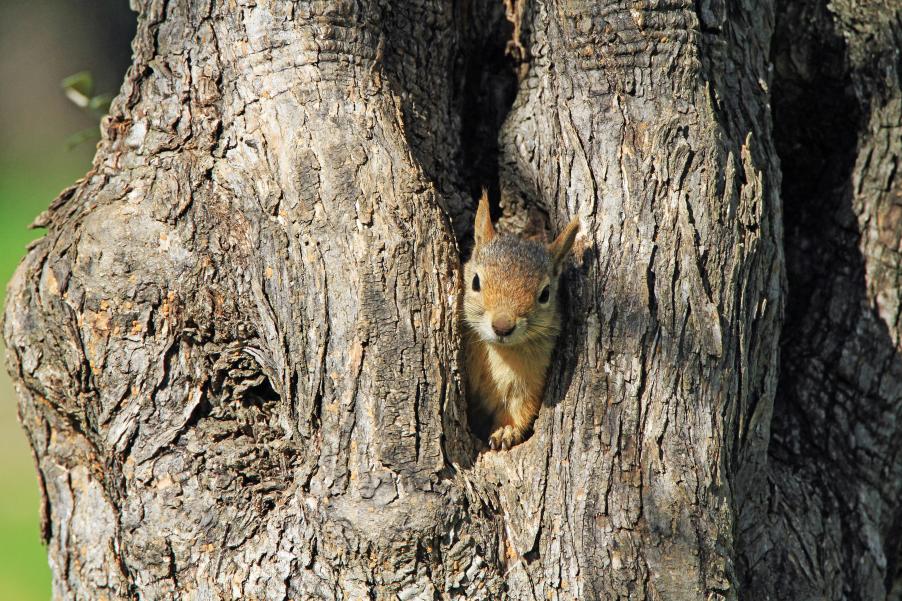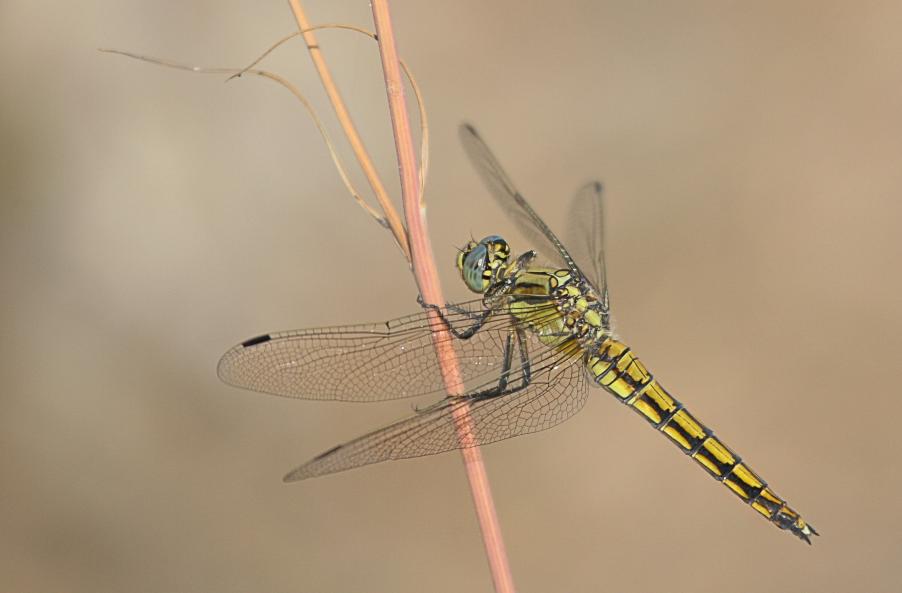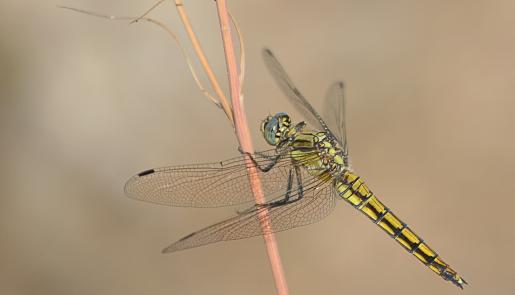
The geographical position and geological background together with the size and diversity of habitats play key roles in Lesvos having a special richness in fauna, that originates from all three continents that meet in the area. Find below the basic animal groups recorded on the island. In the coming period, we will be able to provide you with printable lists of all expected animals of Lesvos.
Mammals
The Persian Squirrel (Sciurus anomalus), has its European distribution restricted on Lesvos and is the most famous mammal in our area. Nevertheless, the most "important" one is the Globally Threatened species of the Mediterranean Monk Seal (Monachus monachus), which breeds in coastal caves around the island.
The carnivorous land mammals are represented by species such as the Red Fox (Vulpes vulpes), the Stone Marten (Martes foina), the Weasel (Mustela nivalis), the Otter (that hasn't been recorded since 1996), the Esatern Hedgehog (Erinaceus concolor), the Bi-coloured White-toothed Shrew (Crocidura leucodon), the Lesser White-toothed Shrew (Crocidura suaveolens), the Pygmy White-toothed Shrew (Suncus etruscus). Also the European Hare (Lepus europaeus) and European Wild Rabbit (Oryctolagus cuniculus), the Lesser Mole Rat (Nanospalax leucodon), the Gunther's Vole (Microtus guentheri), the Yellow-necked Mouse (Apodemus flavicollis), the Eastern Broad-toothed Field Mouse (Apodemus mystacinus), the Wood Mouse (Apodemus sylvaticus), the House Mouse (Mus domesticus), the Black Rat (Rattus rattus) and the Brown Rat (Rattus norvegicus).
The island has an impressive number of bat species (again insectivores), with several threatened and strictly protected species: Greater Horseshoe Bat (Rhinolophus ferrumequinum), Lesser Horseshoe Bat (Rhinolophus hipposideros), Blasius' Horseshoe Bat (Rhinolophus blasii), Mediterranean Horseshoe Bat (Rhinolophus euryale), Mehely's Horseshoe Bat (Rhinolophus mehelyi), Serotine Bat (Eptesicus serotinus), Schreiber's Bat (Miniopterus schreibersii), Greater Mouse-eared Bat (Myotis myotis), Lesser Mouse-eared Bat (Myotis oxygnathus), and Long-fingered Bat (Myotis capaccinnii).
Besides the Mediterranean Monk Seal, there are at least three other sea mammals in the coastal zone: the Common Bottle-nosed Dolphin (Tursiops truncatus), the Short-beaked Common Dolphin (Delphinus delphis), and the Striped Dolphin (Stenella caeruleoalba).
.
Reptiles
.
There are two species of terrestrial tortoises the Greek or Mediterranean Spur-thighed Tortoise (Testudo graeca) and the Marginated Tortoise (Testudo marginata). The latter has been introduced to the island and is found in small numbers and in certain areas. Also, two species or terrapins the Striped or Balkan Terrapin (Mauremys rivulata) and the European Pond Terrapin (Emys orbicularis). Both of them can be found mainly in freshwater wetlands such as lakes, marshes, canals, dams, etc.
In the sea surrounding Lesvos all the three turtles found in the Mediterranean sea can be observed: the Loggerhead (Caretta caretta), the Green (Chelonias mydas), and the Leatherback Sea Turtle (Dermochelys coriacea). Only the Loggerhead Sea Turtle breeds in Greece but only unsuccessful egg-laying attempts of it have been recorded on the island.
Lizards
Out of the eight lizard species of the island, two are rather special: The Snake-eyed Lizard (Ophisops elegans) found only within the Balkan Peninsula and the newly declared species of Eastern Balkan Green Lizard (Lacerta diplochondrodes). The rest of the recorded species are: European Glass Lizard (Pseudopus apodus), Starred Agama (Stellagama stellio), Snake-eyed Skink (Ablepharus kitaibelii), Mediterranean House Gecko (Hemidactylus turcicus), Kotschy's Gecko (Mediodactylus kotschyi). In recent years a few restricted to certain areas (Molivos and Mitilini) populations of the Moorish Gecko (Tarentola mauritanica) have been discovered- a species of African origin.
Lesvos has 12 species of snakes, very special of which are the Ottoman Viber Οχιά (Montivipera xanthina) found only on the Eastern Aegean islands and Eastern Thrace (Northern Greece), the Sand Boa (Eryx jaculus) and the threatened Leopard Snake (Zamenis situla). Other species are the Grass Snake (Natrix natrix), Pond Snake (Natrix tessellate), Caspian Whipsnake (Dolichophis caspius), the Dwarf Snake (Eirenis modestus), the Dahl's Whip Snake (Platyceps najadum), Cat Snake (Telescopus fallax), the Eastern Montpellier Snake (Malpolon insignitus) and the European Blind Snake (Xerotyphlops vermicularis). The most recent addition to the snake list of the island is the ?? (Hemorrhois nummifer)
Greece has 76 different species of reptiles, 21 of which can be found on Lesvos.
Αmphibians
Five species of amphibians are distributed on the "island of wetlands", out of the 25 found within Greece. Three toads (that can be found away from water when fully grown) the Green (Bufotes viridis), the Common (Bufo bufo) (with very few and old records), and the Eastern Speadfoot (Pelobates syriacus). There are also two species of frogs the Levant Water Frog (Pelophylax bedriagae) and the Eastern Tree Frog (Hyla orientalis).
Invertebrates

Lesvos is considered to be a "paradise" for three more flying groups of organisms (besides birds!): for Damselflies and Dragonflies, Butterflies and Wild Bees!
Damselflies and Dragonflies depend greatly on the freshwater wetlands (ponds, rivers, springs, canals, reservoirs, etc) as they spend the majority of their life cycle (egg, nymph) in the water, and only the fully grown insect can live away from it. Fourty different species of dragonflies have been recorded on Lesvos, while the European list has 133. The list becomes longer every year and some of the special species to see on the island are the Odalisque (Epallage fatime), the Dark Spreadwing (Lestes macrostigma), the Small Skimmer (Orthretrum taeniolatum), the Violet Dropwing (Trithemis annulata), etc.
The wealth in Butterflies and Wild Bees is surely connected to the wealth in wild flowers for several species blossom all Spring, Summer, and Autumn. More than 80 species of Butterflies have been recorded on the island while the species of bees exceed 550 (the equivelant of the species list of a small country in central Europe).
The maritime invertebrate Mediterranean Noble Pen Shell (Pinna nobilis) is threatened nowadays throughout the Mediterranean Sea as infected by a parasite for the species. Large populations of this shell are found dead on the shores of both the Kalloni and Gera Gulf.
Fish
The fauna of rivers and streams of Lesvos is equally special. We find here two species of "Critically endangered" fish species the Lesvos Stone Loach (Oxynoemacheilus theophilii) and the Anatolian Barbel (Barbus pergamonensis) and the and two species of "Vunarable" fish the Lesvos Chub (Squalius cii) and the Smyrna Carp (Petroleuciscus smyrnaeus). The Lesvos Stone Loach is considered to be endemic to the island while the other species can also be found in rivers of Western Turkey, although all of them could well have evolved to different species, due to isolation from the area of origin of Asia Minor.
Several wetlands of brackish water (salt-pans and lagoons) are inhabited by the Mediterranean Banded Killifish (Aphanius fasciatus), an endemic to the Mediterranean region.

